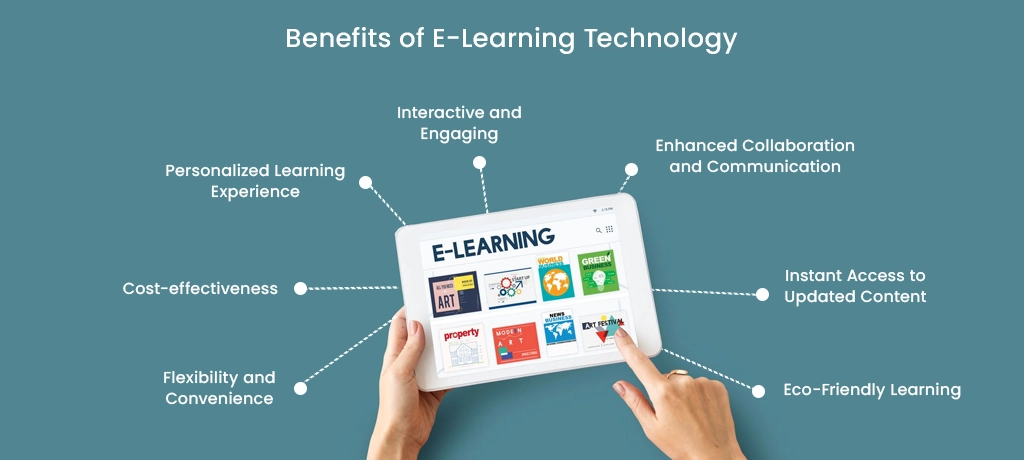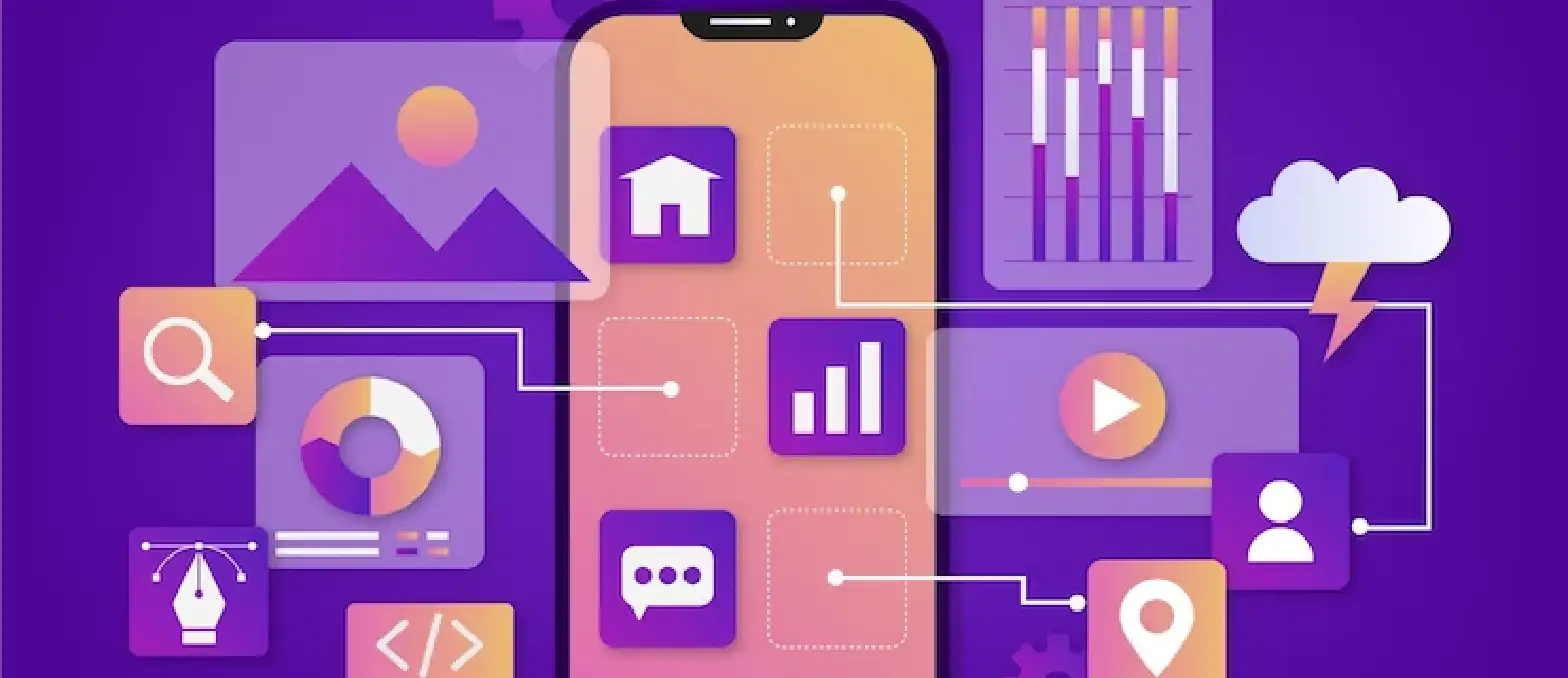Table of Contents
The wave of digital change touches every corner of our world, even the realm of education. The birth of new tech gizmos, smart tools for teachers, and groundbreaking gear has spurred the growth of e-Learning solutions.
Are you fed up with the old-school learning methods? Craving for a fresh approach? This article is just the ticket!
eLearning, a standout marvel of the 21st Century, has carved out a vital role in higher education. It’s particularly handy for busy professionals. To stay afloat in this fast-paced world, it’s crucial to stay in tune with the latest tech buzz.
Now, with a buffet of engaging teaching tech at our fingertips, it’s a breeze to soak up knowledge at your own pace and space. For instance, eLearning and education apps are simplifying the teaching-learning process, making education a click away and hassle-free.
The eLearning software development field has adapted to fresh demands, bringing sweeping changes across industries. The rise of smartphones and budget-friendly data has made computer and internet-based learning methods increasingly reachable.
Now, let’s dive into the tech breakthroughs propelling eLearning to new heights:
Big Data Analytics
Big data analytics is a method that digs deep into vast amounts of data to find trends and patterns. In online learning or e-learning, this means gathering information on how students learn, their likes and dislikes, and their results. This information then tailors the learning journey for each student.
Big data has truly transformed the world of e-learning. It’s now simpler for experts to craft engaging, tailored, and informative lessons because of big data analytics. This tech has made it easier to grasp consumer behavior and wants. It sifts through heaps of data quickly, providing valuable insights. Big data’s role in e-learning has skyrocketed growth and the immediate feedback from users has pushed this platform to new heights.
A major benefit of using big data analytics services in e-learning is the ability to adapt to each learner. With adaptive learning, the online learning platform can alter the content and speed of the course based on the student’s progress and learning habits. This method helps students learn better and quicker. Plus, big data analytics can also pinpoint where students find it tough. By looking at the data, e-learning platforms can offer focused help and resources to help students conquer these hurdles.
Hence, bringing big data analytics into e-learning is a huge leap forward in learning technology. An education app development company can always find fresh ways to blend big data analytics into enhancing the learning journey. As technology keeps moving forward, we can look forward to even more breakthroughs in e-learning.
Virtual Reality and Augmented Reality
In the world of tech, Virtual Reality (VR) and Augmented Reality (AR) are big deals! These cool tools have grown popular in recent years, due to smart devices. Now, they’re changing the way we learn online, making it more hands-on and fun, especially when we use VR gadgets. AR VR solutions help online teachers show their students things in 3D. It’s like bringing real-world examples and demos into the classroom. This helps students understand their subjects better.
One big plus of using AR and VR in online learning is how they help students see complicated ideas. This makes it easier for students to understand and remember what they’ve learned. For example, medical students can practice surgeries in VR, boosting their surgical skills. On the other hand, architecture students can use AR to see and change 3D models of buildings.
What’s more, VR and AR make learning personal. They let students work with the lessons at their own speed, in a way that suits them best. This boosts student engagement and drive, leading to better learning results.
VR and AR are quickly changing how we learn online. They offer new ways to share educational content. Mobile app development companies can use these tools to make online learning more engaging and immersive, which improves learning results. As more people want e-learning mobile app development, we can look forward to seeing more uses of VR and AR in education.
Microlearning
In this busy world, full-on e-learning is often a luxury that working individuals can’t afford. That’s where microlearning steps in, offering nuggets of knowledge that are both small and meaningful. It’s like having an infographic that captures the essence of a 10-page book – quite a marvel, isn’t it?
Many e-learning providers are embracing microlearning due to its affordability, swift deployment, and ease of updating. Its formats vary – from short videos, infographics, and webinars, to podcasts and more.
For example, imagine having bite-sized educational videos of just 5-10 minutes or single-page articles that simplify complex theories. This empowers busy professionals to undertake e-learning courses and augment their knowledge in minimal time.
Microlearning is rapidly gaining favor among educators and learners alike, and for good reasons.
- Firstly, it offers flexibility and convenience. Learners can access these bite-sized modules anytime, anywhere, using their smartphones or other mobile gadgets. This makes learning not only accessible but also a seamless fit into their hectic schedules.
- Secondly, microlearning boosts learning outcomes and retention rates. The concise and targeted nature of these activities facilitates easier information processing and retention. By dissecting complex concepts into smaller, manageable parts, learners can comprehend and recall the material more effectively.
Moreover, microlearning is not just about learning; it’s about an engaging and interactive experience. Educational app development companies are weaving elements like gamification, quizzes, and more into their e-learning mobile app development. This approach not only boosts learner motivation but also strengthens learning outcomes.
Lastly, microlearning is economical and efficient. It does away with the need for extended classroom sessions and costly training programs. Instead, learners have access to brief, focused learning activities tailored to their unique needs and objectives.
Personalized Learning
Traditional learning has a key shortcoming: it offers the same study material to all learners, regardless of their individual abilities. But eLearning solution providers have recognized the demand for more bespoke content. This strategy gives us customized eLearning solutions, designed to cater to every individual’s unique talents, abilities, and interests.
This tailored content is a cornerstone of competency-based learning. It provides education and guidance to each learner according to their own pace of understanding. This includes things like specific e-tutorials, videos, and digital study resources, all carefully crafted to match each person’s understanding level.
Our custom eLearning solutions incorporate things like adaptive learning platforms. These make use of data analytics and machine learning techniques to personalize the learning journey. There are also learning management systems (LMS) that suggest personalized learning routes and content based on the behavior and likes of the learner.
Tailored learning has many upsides. Learners feel more involved when they have a say in their learning journey. It lets them focus on what they find interesting and move past what they already know. Plus, it lets learners go at their own speed, ensuring they have the time and tools needed to fully grasp the material.
Educators reap the rewards of tailored learning too. It lets them direct their time and resources to learners who need the most support. By offering customized content and teaching, tailored learning can help educators more effectively assist learners of all kinds and learning styles.
Tailored learning is revolutionizing the e-learning sector, giving learners a more engaging and efficient way to learn. With the assistance of eLearning solution providers, organizations can roll out custom eLearning solutions, bringing personalized learning experiences to all.
Cloud-Based Learning
Cloud services are truly transforming our world, and the field of e-learning is feeling the impact. For organizations, cloud computing services have become a game-changer, offering both cost and data saving benefits. One standout feature is cloud-based learning. This lets teachers share digital lessons far and wide with ease.
Cloud-based data sharing has also tackled a big issue – copyright breaches. Now, teachers can share data securely, reaching only the intended learners instead of making it public online. Plus, uploading to the cloud is quick and easy.
A big win for learners is the freedom that cloud-based learning offers. They can tailor their learning journey to fit their needs and wants. From picking the topics they want to study, to choosing their own pace and device, the learner is in control.
For eLearning solution providers, cloud-based learning is also a cost-saving tool. It removes the need for pricey hardware and software infrastructure, helping to keep the budget in check. Beyond the cost, it allows eLearning solution providers to create custom e-learning solutions for their clients.
So, what’s the bottom line? Cloud-based learning is a revolutionary shift in e-learning tech. It’s a win-win for learners, teachers, and eLearning solution providers alike. Learners can access educational resources whenever and wherever they want, as long as they have an internet-connected device. For eLearning app development firms, it offers the chance to provide unique e-learning solutions to clients, helping them stand out from the crowd.
Virtual Classrooms
Elearning, or online learning, faced a big challenge: it lacked the warmth of human interaction. However, the tide turned with the advent of Virtual Classrooms. These tech-powered classrooms brought a lively, interactive element to e-learning. They have made it easy for students and teachers to converse, cooperate, and share ideas. The learners now have the liberty to choose their teachers. This incredible feature has proven to be a boon for both eLearning and its users.
In simple terms, Virtual Classrooms connect teachers and learners in real time, just like a traditional classroom. They come loaded with handy key features like video calls, screen sharing, and digital whiteboards. These tools let students engage in group chats, ask doubts, and receive immediate feedback from teachers.
A big plus of Virtual Classrooms is their adaptability. Students can join classes from any corner of the globe, given they have internet access. This opens the door to education for people who might not otherwise get the chance to learn new skills and upgrade their career prospects.
These Virtual Classrooms are extremely customizable too. eLearning solution providers can craft tailor-made educational solutions to suit a specific organization or industry. For instance, a firm focused on software development might want its staff to take up courses on coding languages or database management. With a Virtual Classroom, these courses can be custom-built to align with the company’s specific requirements, guaranteeing that employees learn the vital skills they need for their jobs.
Another advantage of Virtual Classrooms is their cost-effectiveness. They are often cheaper than traditional classroom learning. With Virtual Classrooms, there are no costs tied to maintaining a physical classroom, like rent, utilities, or equipment. This allows mobile app development services provider to offer courses at a much lower price than conventional classroom-based courses.
Extensive E-learning Trends to Look Into Mobile Learning
The latest findings suggest that the global smartphone users count in 2023 stands at approximately 6.925 billion, a considerable increase from the 5.095 billion recorded five years prior. Projections indicate that this number is expected to rise to about 7.69 billion by the conclusion of 2027. These figures show that creating any e-learning software must consider a mobile-first approach. The surge in eLearning solutions means we no longer need to be stuck in one place to learn. These solutions are transforming how we learn, taking full advantage of mobile technology.
This change will continue, with mobile learning offering flexibility and greater access than traditional methods. The future might see the blending of mobile and immersive technologies for a groundbreaking learning experience.
Social Learning
Social learning isn’t new. Over time, it’s enhanced, becoming a favorite in modern workplaces.
Social learning tools like chats, forums, learning circles, and sharing sessions make learning open, efficient, and practical. The rise of the learning experience platform, coupled with strong communication tools, is driving this change.
The advantages of social learning include fostering collaboration and teamwork. It lets students work together, share ideas, and give each other feedback. This collaborative approach aids in understanding complex concepts and developing critical thinking skills.
Social learning can make students feel more connected with their teachers and peers. It creates a community, fostering relationships that can last beyond the classroom. E-learning providers should continue incorporating social learning into their custom education solutions to offer the best possible learning experiences.
Work-life Skills
The pandemic forced everyone to learn new skills online. This shift prompted digital product engineering services to create intuitive, robust learning platforms.
The evolution of learning methods has brought about new subjects and goals. Skills like communication, leadership, problem-solving, and collaboration are helping employees excel at their jobs.
E-learning courses cover a range of topics. Key skills individuals need include time management, goal setting, communication, stress management, and decision-making. These are vital for achieving a healthy work-life balance and overall productivity.
E-learning providers are offering more custom education solutions to cater to different individuals and organizations. This personalized approach lets individuals choose courses that align with their goals. Custom education solutions also allow organizations to tailor e-learning courses to meet their employees’ specific needs, boosting their productivity and performance.
Adaptive Learning
Adaptive learning is gaining traction. According to the annual L&D global sentiment survey, it topped the list of trending learning practices.
Adaptive learning focuses on personalizing the learning experience. Learners can use technologies like robust analytics, confidence-based assessment, and pre-learning tests.
One of the top eLearning trends for corporate training is to highlight custom learning activities with custom LMS development solutions.
Companies can opt for algorithm adaptivity or designed adaptivity. Based on preferences and learning habits, either mode can be adopted. Companies can also optimize resources to achieve better training and a higher ROI.
Artificial Intelligence
Artificial Intelligence (AI) is a hot trend in elearning. It’s powering modern learning and development platforms. Pairing your LCMS software with AI can revolutionize your eLearning space.
AI’s powerful algorithms can quickly collect data like learners’ strengths, weaknesses, interests, and proficiency to create personalized learning experiences. Companies can use AI to develop intelligent chatbots to train learners with special needs or those seeking knowledge on critical topics.
It’s predicted that we’ll see more AI tutors and platforms using machine learning algorithms to match students to tutors based on responses to a series of questions.
Gamification and Game-based Learning
Gamification in eLearning aims to increase engagement and retention rates. It’s a modern learning strategy, and it’s here to stay. It aims to boost both engagement and memory retention. Various gamification types are available today, each contributing to the effectiveness of learning.
A 2020 survey suggests that game-based learning platforms could raise revenue by $28.8 million by 2025.
Gamification can help simplify the learning process. By engaging IT consultation services, companies can make course content more appealing, elevate motivational levels, and enhance content retention. This approach is effective for corporate training and fostering emotional and intensive learning experiences.
Custom Education Solutions
Custom education solutions are becoming more prominent in today’s e-learning environment. Providers are developing personalized courses to cater to the unique needs of each learner, be it an individual or an organization. These custom solutions ensure that each student gains the most out of their e-learning experience, and organizations can tailor their e-learning courses to meet their employees’ specific needs.
Product Engineering Services
The digital shift in learning methods has also created an opportunity for product engineering services. By developing robust and intuitive learning platforms, these services are ensuring that the learning process is not only efficient but also engaging. This approach creates an environment where both the student and the organization can thrive.
From mobile learning to social learning, from work-life skills to adaptive learning, and from AI applications to gamification, the landscape is dynamic and exciting. With the help of custom LMS development, LCMS software, and IT consultation services, companies can ensure they are at the forefront of these changes, delivering optimal learning experiences to their users.
Advantages of E-Learning Technology
Flexibility and Convenience
One significant advantage of e-learning technology is its flexibility. With traditional classroom learning, one must adhere to a fixed schedule and location. But with e-learning, you can learn whenever you want and wherever you are. It’s like having a portable classroom that fits right into your pocket! Whether you’re a busy professional trying to upgrade your skills or a parent learning to cook new dishes, e-learning technology can adapt to your pace and schedule.
Cost-effectiveness
E-learning technology also offers an economic advantage. Traditional learning methods often involve hefty tuition fees, travel expenses, and course materials. E-learning, on the other hand, eliminates many of these costs. You just need a device with internet access, and you’re all set to embark on your learning journey. This cost-effectiveness makes education more inclusive, breaking down financial barriers that could hinder learning.
Personalized Learning Experience
E-learning technology allows for a more personalized learning experience. Traditional classrooms typically follow a “one size fits all” approach, which might not cater to the unique learning styles of each student. E-learning, however, allows learners to control their learning process. They can revisit difficult topics, skip ahead to more advanced lessons, or even slow down the pace if needed.
Interactive and Engaging
E-learning technology employs various interactive tools to make learning more engaging. Think of it like playing a video game, where you’re not just observing but actively participating. From interactive quizzes to virtual simulations, e-learning technology can transform the most mundane lessons into exciting experiences. This interactivity helps learners retain information better, making the learning process more effective.
Enhanced Collaboration and Communication
E-learning technology fosters a collaborative learning environment, even when participants are miles apart. It incorporates tools that facilitate communication, such as discussion forums, live chats, and video conferencing. These tools allow learners to interact with their peers, share ideas, and seek help when needed. Moreover, learners can connect with experts or mentors from around the globe, expanding their learning opportunities. This heightened level of interaction and communication enhances the learning experience, promoting a sense of community and shared learning.
Instant Access to Updated Content
Another remarkable benefit of e-learning technology is its ability to provide instant access to the most current information. In the traditional learning system, updating course materials can be a time-consuming process. However, with e-learning technology, content can be updated in real-time and made available to all learners immediately. This is particularly important in fields where new information is constantly emerging, such as technology, medicine, or business. Thus, e-learning ensures that learners always have the most relevant and up-to-date knowledge at their fingertips.
Eco-Friendly Learning
E-learning technology is also a greener option for learning. Traditional education systems rely heavily on paper for books, handouts, and exams, leading to massive paper consumption. On the contrary, e-learning is a paperless mode of learning, reducing the demand for paper and thereby lessening the strain on our environment. In addition, it eliminates the need for physical travel, reducing carbon emissions associated with transportation. Hence, e-learning technology not only benefits the learners but also contributes positively to our environment.
Embrace the Future of Learning: Join the Digital Revolution Today!
Bottom Line
In short, the tech leaps we’re seeing are truly changing how e-learning works. Sure, trying new tech can feel tough. But, if we get the hang of these 2020 trends, they’ll bring real perks to e-learning. What’s more, blending the newest technologies with the e-learning platform can offer great learning moments to everyone.
So, any firm that builds e-learning software must add these tech trends. This way, they can stay in step with a market that changes fast.
FAQs
What is an e-learning study?
E-learning study is about gaining knowledge through digital tools like computers, phones, or tablets. It lets people learn from anywhere, at any time. E-learning can be things like online classes, virtual classrooms, or educational videos. It can be at your own pace or guided by a teacher. There are often quizzes to check how well you’re learning. It’s handy, adaptable, and made just for you. More and more people like e-learning because it’s not costly, it can grow quickly, and it can reach people all over the world.
What is the need for e-learning?
E-learning helps the learners to understand the concepts more easily. By using AI applications and gamification strategies in e-learning apps, learning becomes fun. eLearning apps improves productivity and performance of learners. Adequate training is also provided through eLearning apps.
What advancements in technology can be made to improve online learning?
With advancements in technology like AR and VR, Big Data Analytics, and AI, it is possible to create interactive experiences for learners. As a result, it enhances their knowledge. The content becomes engaging which drives student’s attention. Also, with cloud-based learning and personalized learning, ease of access is strengthened, and it’s also cost-effective.
What are the current trends in e-learning?
Right now, e-learning is all about microlearning, gamification, adaptive learning, and personalized learning. Microlearning breaks down the info into small bits. Gamification makes learning feel like a game. Adaptive learning uses data and tech to tailor learning to the student. Personalized learning lets students set their own goals. E-learning is also starting to use more artificial intelligence and virtual reality to make learning better.







